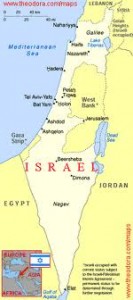This issue looks at the non-existent Palestine.
SINCE YOU ASKED
It won’t be long until the U.N. General Assembly will likely vote for collective recognition of a Palestinian state, but which one? The situation is such a mess that there are now three separate “Palestinian State” entities that must be sorted out. Of these three, the first two are real and could possibly meet the requirements for statehood. The first is Hamas-controlled Gaza. The second is the Fatah-controlled West Bank. The third could best be described as “imaginary.” It consists of Gaza, the West Bank, East Jerusalem, and all the other parts of mandatory Palestine that were under Jordanian and Egyptian control before 1967. This is the one the assembly will likely endorse.
recognition of a Palestinian state, but which one? The situation is such a mess that there are now three separate “Palestinian State” entities that must be sorted out. Of these three, the first two are real and could possibly meet the requirements for statehood. The first is Hamas-controlled Gaza. The second is the Fatah-controlled West Bank. The third could best be described as “imaginary.” It consists of Gaza, the West Bank, East Jerusalem, and all the other parts of mandatory Palestine that were under Jordanian and Egyptian control before 1967. This is the one the assembly will likely endorse.
The 1933 Montevideo Convention on the Rights and Duties of States (the prevailing legal standard),requires that a “state as a person of international law should possess the following qualifications: a) a permanent population; b) a defined territory; c) government; and d) capacity to enter into relations with the other states.”
In Gaza, Hamas controls a permanent population in a defined territory (i.e., Gaza within the armistice lines of 1949). Gaza has a functioning government (of sorts), and has international relations with a large number of states. Gaza alone is not and will never be on the table for statehood. Hamas wants all of Israel, not just tiny Gaza.
The Fatah-controlled West Bank could also meet the legal requirements for statehood, and it would have more international support. It has a functioning government in the Palestinian Authority (PA), a permanent population, and international relations with a very large number of states. It also controls a defined territory. Like Gaza, the West Bank alone is not and will never be on the table for statehood. It, too, is not enough.
AS I SEE IT
The big problem here is that the Palestinian entity to be voted on doesn’t exist and fails to meet any of the requirements for statehood. Who would emerge as president is up for grabs. Despite the so-called unity agreement, Hamas and Fatah haven’t gotten beyond their differences. Fatah’s Mahmoud Abbas is presenting himself as the president of the Palestine that is requesting statehood at the U.N., but Hamas has the law on its side in no longer recognizing him as President. So much for having a functioning government. To make matter worse, the Palestinian entity requesting statehood will have a legislature that has never met. Since being elected on Jan. 25, 2006, (for a term of four years), the Palestinian Legislative Council (PLC) has yet to enact a single law, issue a single appointment, of conduct a single meeting. Abbas has claimed that it is his right as president to legislate laws and decisions by decree.
Finally, the Palestine the General Assembly will recognize will be unable to hold presidential or legislative elections as required by Article 47 of its Basic Law simply because the rival Palestinian rulers, each for their own reasons, will not allow them to happen.
So there you have it. The General Assembly is likely to try to create an imaginary state that has two incompatible presidents, two rival prime ministers, a constitution that is being violated by both sides, no functioning legislature, no ability to hold elections, a population mostly not under its control, borders that would annex territory under the control of other powers, and no clear path to resolve any of these conflicts. What could possibly go wrong?
ON THE LIGHTER SIDE
There are two theories to arguing with a woman. Neither works.
–Will Rogers





Leave A Comment